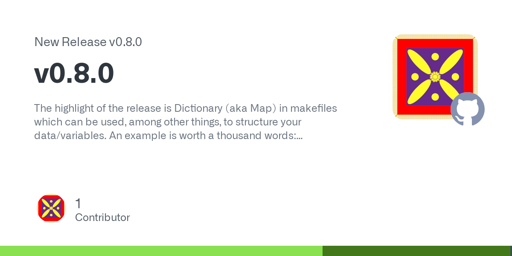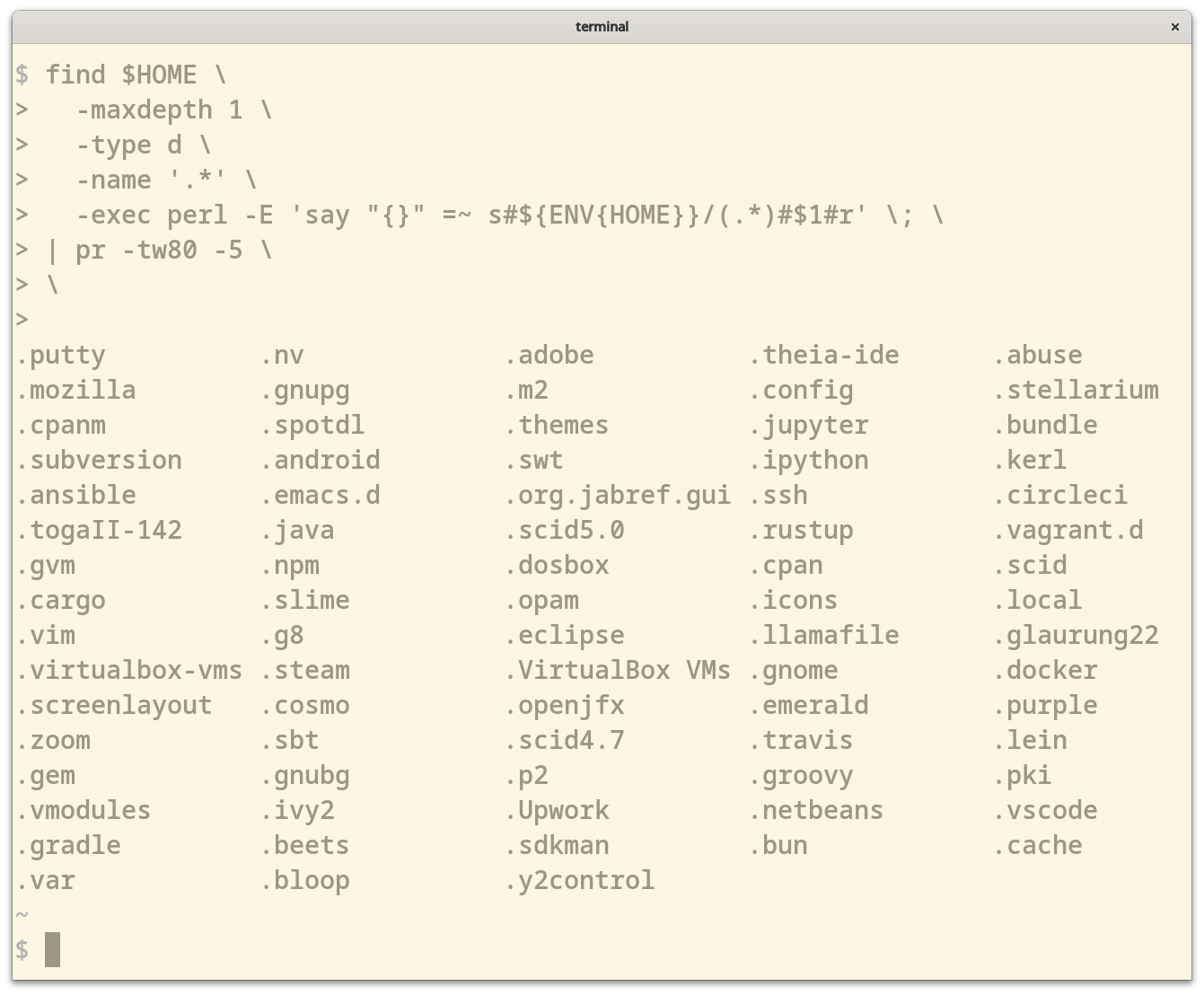bahmanm
Husband, father, kabab lover, history buff, chess fan and software engineer. Believes creating software must resemble art: intuitive creation and joyful discovery.
Views are my own.
- 27 Posts
- 99 Comments
Besides the fun of stretching your mental muscles to think in a different paradigm, Forth is usually used in the embedded devices domain (like that of the earlier Mars rover I forgot the name of).
This project for me is mostly for the excitement and joy I get out of implementing a Forth (which is usually done in Assembler and C) on the JVM. While I managed to keep the semantics the same the underlying machinery is vastly different from, say, GForth. I find this quite a pleasing exercise.
Last but not least, if you like concatenative but were unable to practice fun on the JVM, bjForth may be what you’re looking for.
Hope this answers your question.
Whoa! This is pretty rad! Thanks for sharing!
That’s definitely an interesting idea. Thanks for sharing.
Though it means that someone down the line must have written a bootstrap programme with C/Assembler to run the host forth.
In case of jbForth, I decided to write the bootstrap too.
That’s impossible unless you’ve got a Forth machine.
Where the OS native API is accessible via C API, you’re bound to write, using C/C++/Rust/etc, a small bootstrap programme to then write your Forth on top of. That’s essentially what bjForth is at the moment: the bootstrap using JVM native API.
Currently I’m working on a set of libraries to augment the 80-something words bjForth bootstrap provides. These libraries will be, as you suggested, written in Forth not Java because they can tap into the power of JVM via the abstraction API that bootstrap primitives provide.
Hope this makes sense.
Haha…good point! That said bjForth is still a fully indirect threaded Forth. It’s just that instead of assembler and C/C++ it calls Java API to do its job.
Good question!
IMO a good way to help a FOSS maintainer is to actually use the software (esp pre-release) and report bugs instead of working around them. Besides helping the project quality, I’d find it very heart-warming to receive feedback from users; it means people out there are actually not only using the software but care enough for it to take their time, report bugs and test patches.
“Announcment”
It used to be quite common on mailing lists to categorise/tag threads by using subject prefixes such as “ANN”, “HELP”, “BUG” and “RESOLVED”.
It’s just an old habit but I feel my messages/posts lack some clarity if I don’t do it 😅
I didn’t like the capitalised names so configured xdg to use all lowercase letters. That’s why
~/optfits in pretty nicely.You’ve got a point re
~/.local/optbut I personally like the idea of having the important bits right in my home dir. Here’s my layout (which I’m quite used to now after all these years):$ ls ~ bin desktop doc downloads mnt music opt pictures public src templates tmp videos workspacewhere
binis just a bunch of symlinks to frequently used apps fromoptsrcis where i keep clones of repos (but I don’t do work insrc)workspaceis a where I do my work on git worktrees (based offsrc)

 151·2 years ago
151·2 years agoThanks! So much for my reading skills/attention span 😂
Which Debian version is it based on?

 133·2 years ago
133·2 years agoSomething that I’ll definitely keep an eye on. Thanks for sharing!
RE Go: Others have already mentioned the right way, thought I’d personally prefer
~/opt/goover what was suggested.
RE Perl: To instruct Perl to install to another directory, for example to
~/opt/perl5, put the following lines somewhere in your bash init files.export PERL5LIB="$HOME/opt/perl5/lib/perl5${PERL5LIB:+:${PERL5LIB}}" export PERL_LOCAL_LIB_ROOT="$HOME/opt/perl5${PERL_LOCAL_LIB_ROOT:+:${PERL_LOCAL_LIB_ROOT}}" export PERL_MB_OPT="--install_base \"$HOME/opt/perl5\"" export PERL_MM_OPT="INSTALL_BASE=$HOME/opt/perl5" export PATH="$HOME/opt/perl5/bin${PATH:+:${PATH}}"Though you need to re-install the Perl packages you had previously installed.

 3·2 years ago
3·2 years agoFirst off, I was ready to close the tab at the slightest suggestion of using Velocity as a metric. That didn’t happen 🙂
I like the idea that metrics should be contained and sustainable. Though I don’t agree w/ the suggested metrics.
In general, it seems they are all designed around the process and not the product. In particular, there’s no mention of the “value unlocked” in each sprint: it’s an important one for an Agile team as it holds Product accountable to understanding of what is the $$$ value of the team’s effort.
The suggested set, to my mind, is formed around the idea of a feature factory line and its efficiency (assuming it is measurable.) It leaves out the “meaning” of what the team achieve w/ that efficiency.
My 2 cents.
Good read nonetheless 👍 Got me thinking about this intriguing topic after a few years.

 4·2 years ago
4·2 years agoThis is fantastic! 👏
I use Perl one-liners for record and text processing a lot and this will be definitely something I will keep coming back to - I’ve already learned a trick from “Context Matching” (9) 🙂

 1·2 years ago
1·2 years agoThat sounds a great starting point!
🗣Thinking out loud here…
Say, if a crate implements the
AutomatedContentFlaggerinterface it would show up on the admin page as an “Automated Filter” and the admin could dis/enable it on demand. That way we can have more filters than CSAM using the same interface.
TBH I use whatever build tool is the better fit for the job, be it Gradle, SBT or Rebar.
But for some (presumably subjective) reason, I like GNU Make quite a lot. And whenever I get the chance I use it - esp since it’s somehow ubiquitous nowadays w/ all the Linux containers/VMs everywhere and Homebrew on Mac machines.

 1·2 years ago
1·2 years agoLove the attitude 💪 Let me know if you need help in your quest.

 2·2 years ago
2·2 years agoI see.
So what do you think would help w/ this particular challenge? What kinds of tools/facilities would help counter that?
Off the top of my head, do you think
- The sign up process should be more rigorous?
- The first couple of posts/comments by new users should be verified by the mods?
- Mods should be notified of posts/comments w/ poor score?

 9·2 years ago
9·2 years agoInteresting topic - I’ve seen it surface up a few times recently.
I’ve never been a mod anywhere so I can’t accurately think what workflows/tools a mod needs to be satisfied w/ their, well, mod’ing.
For the sake of my education at least, can you elaborate what do you consider decent moderation tools/workflows? What gaps do you see between that and Lemmy?
PS: I genuinely want to understand this topic better but your post doesn’t provide any details. 😅












Not really I’m afraid. Effects can be anywhere and they are not wrapped at all.
In technical terms it’s stack-oriented meaning the only way for functions (called “words”) to interact with each other is via a parameter stack.
Here’s an example:
TIMES-10is a word which pops one parameter from stack and pushes the result of its calculation onto stack. The( x -- y)is a comment which conventionally documents the “stack effect” of the word.Now when you type
12and press RETURN, the integer 12 is pushed onto stack. ThenTIMES-10is called which in turn pushes10onto stack and invokes*which pops two values from stack and multiplies them and pushes the result onto stack.That’s why when type
.Sto see the contents of the stack, you get120in response.Another example is
This simple example demonstrates the reverse Polish notation (RPN) Forth uses. The arithmetic expression is equal to
5 * (20 - 10)the result of which is pushed onto stack.PS: One of the strengths of Forth is the ability to build a vocabulary (of words) around a particular problem in bottom-to-top fashion, much like Lisp. PPS: If you’re ever interested to learn Forth, Starting Forth is a fantastic resource.